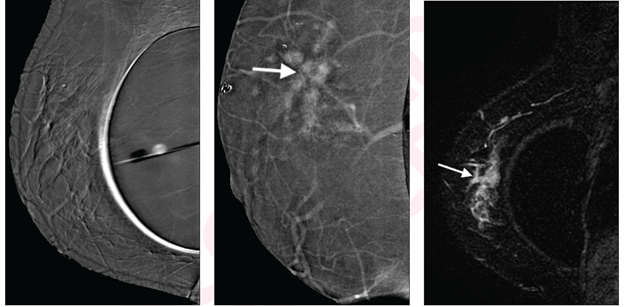Contrast-Enhanced Mammography Equivalent to MRI for Breast Cancer Detection in Women with Implants
Findings show contrast-enhanced mammography is an acceptable option for women who may not have access to MRI or who cannot undergo the exam.
An emerging breast imaging technique – contrast-enhanced mammography (CEM) – performs equally as well as breast MRI in identifying breast cancers in women who have had breast augmentation.
In the first study to investigate how well CEM, which uses iodine to highlight tumor neurovascularity, performs in women who have breast implants, investigators from the Mayo Clinic said their findings show this new imaging option can work for women who either do not have access to MRI or who cannot undergo the scan for a variety of reasons, such as having a pacemaker.
The team, led by Mayo Clinic diagnostic radiology resident Molly Carnahan, M.D., published their findings on March 18 in the American Journal of Roentgenology.
Related Content: GE Healthcare Captures FDA Clearance for Industry-First Contrast-Enhanced Mammography Biopsy
“This preliminary study shows concordance between CEM and MRI in women with newly diagnosed breast cancer and breast augmentation,” she said. “The findings suggest a possible role of CEM for staging in women with breast augmentation and contraindication or limited access to MRI.”
Carnahan’s team reached this conclusion through a retrospective study of 17 women with breast augmentation who underwent both CEM and MRI as part of physician-ordered diagnostic evaluation for newly discovered breast cancer. The average age was 52 – 11 of whom had dense breasts. Any suspicious enhancement on CEM was followed by either an ultrasound-guided, stereotactic-guided, or MR-guided biopsy. In addition, the team said, BI-RADS criteria were used to characterize background parenchymal enhancement, which was consistent for 94 percent of participants on both MRI and CEM, for both scans.
Related Content: GE Healthcare Introduces First Contrast-Enhanced Mammography Biopsy
According to their analysis, CEM and MRI results were consistent for all 17 women. Specifically, the team identified invasive ductal carcinoma in 15 women (88 percent), as well as invasive lobular carcinoma and ductal carcinoma in situ in one woman (6 percent) each. The average size of all tumors was 2 cm with two being mammographically occult, highlighting the decreased sensitivity of mammography in asymptomatic women with breast augmentation.
Left to right: Subtraction right mediolateral oblique (MLO) CEM was non-diagnostic because of artifact, potentially due to motion misregistration from extended exposure time; subtraction right MLO implant displaced CEM image shows 5.8 cm enhancing mass (arrow); contrast-enhanced MRI sagittal subtraction image shows concordant mass (arrow).
Credit: American Journal of Roentgenology

In addition, six other CEM-detected lesions found in six women (35 percent) were confirmed by MRI – three were multi-focal, two were contralateral, and one was multi-centric. Further analysis revealed two were malignant – one invasive ductal carcinoma and one invasive lobular carcinoma. The team noted that MRI did not pick up any cancers not seen on CEM.
Further studies are required, the team said, noting that the small sample size, selection bias, and retrospective study design were limitations. In addition, CEM does have a reduced field-of-view that could hamper any assessments far posterior lesions – those that abut the implant. In those cases, as well as with axillary disease, they said, MRI could be required to fully evaluate disease extent.
For more coverage based on industry expert insights and research, subscribe to the Diagnostic Imaging e-Newsletter here.
AI-Initiated Recalls After Screening Mammography Demonstrate Higher PPV for Breast Cancer
March 18th 2025While recalls initiated by one of two reviewing radiologists after screening mammography were nearly 10 percent higher than recalls initiated by an AI software, the AI-initiated recalls had an 85 percent higher positive predictive value for breast cancer, according to a new study.